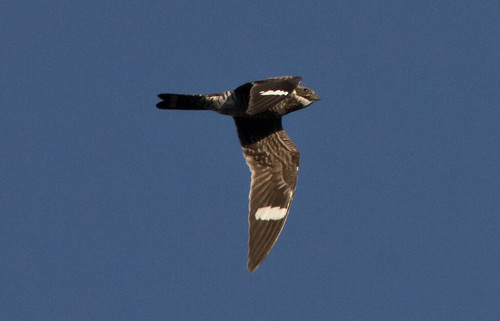For the Birds Radio Program: Nighthawks
Laura talks about a goatsucker that doesn’t suck on goats.
Transcript

(Recording of a Common Nighthawk)
One of the last migrants to return to the Northland each spring is the nighthawk. This crepuscular bird is not a true hawk–it’s in a family called the nightjars, along with the Whip-poor-will. This family is also known as goatsuckers. The huge gape of a nightjar’s mouth seemed to European goat herdsmen just exactly the right size and shape for milking goats dry, and the birds’ habit of sitting on pastures where goats browsed seemed equally damning evidence. If a goatherd flushed one of these big-mouthed birds or heard its “night-jarring” voice in the night stillness, he knew exactly what to blame when one of his goats failed to give milk.
Actually a nightjar’s mouth doesn’t have the kind of musculature necessary to suck anything. Large species, like the Chuck-will’s-widow of the southeastern states, can sweep up songbirds in their huge mouths, but our own nighthawk eats insects only. At least 50 different species of insects are captured on the wing, from the largest moths to the tiniest mosquitoes and gnats. The nighthawk can hunt both high in the air and close to the ground, but it probably also eats bugs as it rests on the ground–the stomach of a nighthawk collected in Maine held 2,175 ants. One from Massachusetts held over 500 mosquitoes–that bird was subsisting at least indirectly on human blood.
The nighthawk is one species of bird that has increased in numbers thanks to urbanization. In the wild it nests on beaches, open barren rocks, bare gravelly soil of fields, or the burned over tracts left by forest fires. But in cities it nests on the flat-topped roofs of buildings, from one-story warehouses to skyscrapers. In Duluth you’re more likely to hear nighthawks downtown than in neighborhoods where most roofs are slanted.
The tar on rooftops can become extremely hot in mid-summer, and the nighthawk has often been seen moving its eggs or young to cooler spots within its territory. A bird’s down jacket is wonderful insulation from cold, but those same feathers also prevent the bird from cooling itself by sweating. To cool off, an adult nighthawk can practice “gular fluttering”. Vibrating the skin on its throat helps evaporate saliva, cooling the bird the way panting cools a dog.
The buzzy call of the nighthawk is heard most frequently at dusk, but I’ve heard it at least occasionally during every hour of the day.
(Recording of a Common Nighthawk)
In Maine, where imaginations run bigger than in Minnesota, people call the nighthawk “pork-and-beans” for this call. A male nighthawk can also make a booming sound by holding its wings just right at the bottom of a deep courtship dive. Rushing air vibrates the primary wing feathers to cause the boom, which gave the nighthawk another nickname– the bull-bat.
As long as night-flying insects are plentiful, nighthawks rest during the day. They perch horizontally on fence posts, barn rafters, thick tree branches, and, once in a while, on deck railings.
(Recording of a Common Nighthawk)
This is Laura Erickson, and this program has been “For the Birds.”
